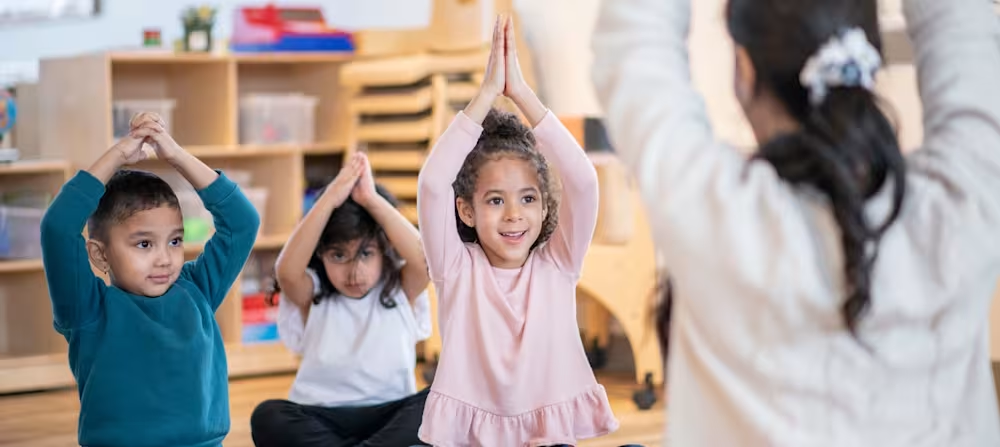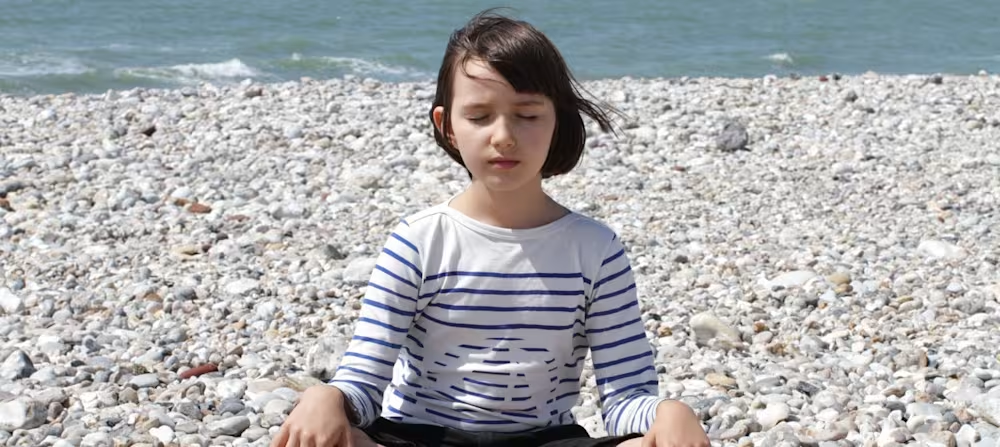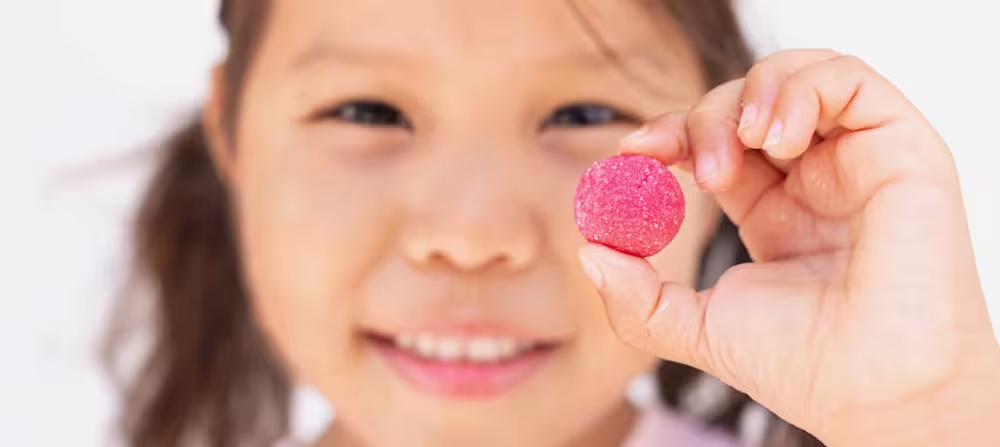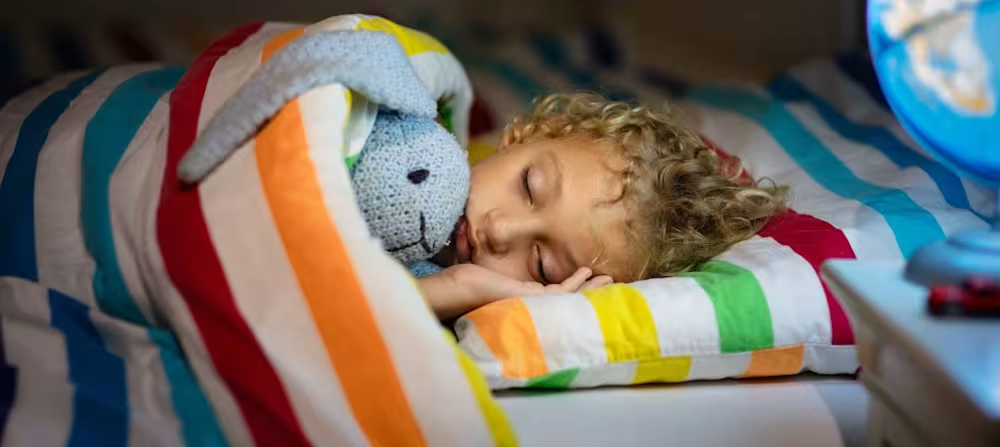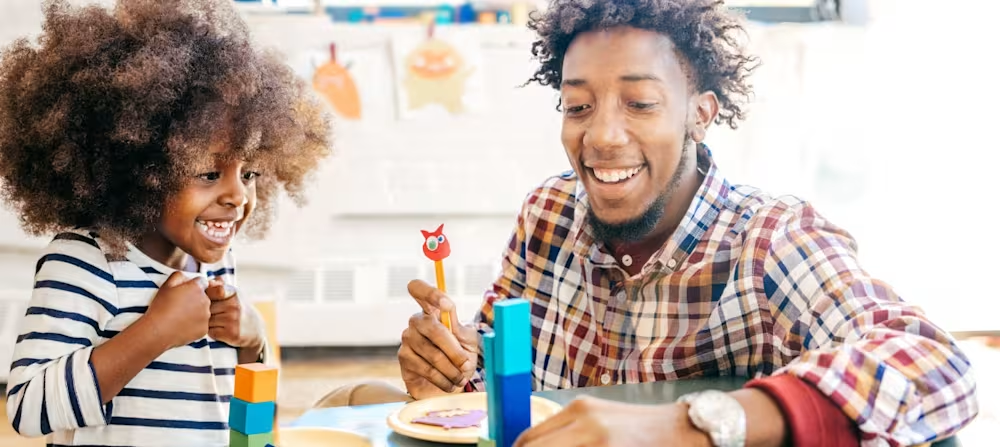Sleep meditation for kids: Promoting peaceful nights and restful sleep
Updated Aug 14, 2025

Bedtime often becomes a source of frustration in households with kids. Parents are tapped out and ready to call it a day, while the kids have their game face on, ready to battle for more awake time. Exasperation and tantrums abound, and the more agitated you become, the more activated the kids become, and the farther from sleep you both get. Sound familiar?
But there is a simple solution to this bedtime grievance.
Kids' sleep meditation can help with it all: , parental frustration, and a child’s willingness to relax and drift off to sleep (in a timely fashion!). Meditation is a calming that activates the relaxation response. When a child’s body and mind are relaxed at bedtime, they become more willing to rest. They’ll also fall asleep faster and experience higher quality sleep.
In this blog, we’ll cover: the basics of sleep meditation, what it is, how to create an environment that supports relaxation, accessible breathing and relaxation techniques, mindfulness practices for better sleep, and some specific tips for parents who want to incorporate meditation into the bedtime routine.
Understanding sleep meditation for kids
Don’t let the term “meditation” scare you away. We’re not talking about 20 minutes of complete silence and stillness and a brain devoid of thought. Meditation for kids and beginners (even adult beginners) is much easier. It taps into a child’s intrinsic love of feeling good, keeps them focused through creativity and imagination, and lasts just a minute or so per year of life (e.g. three minutes of meditation for a 3 year old, and four minutes of meditation for a 4 year old).
Your child can meditate, and so can you! We hope you’ll give it a try and see for yourself how it can improve bedtime with your child.
Activities that turn on the relaxation response have been shown to improve sleep. Benefits of meditation for children include improved mood, reduced blood pressure, lower stress, and reduced anxiety []. Regular meditation practice also fosters a healthy mind-body connection, which will serve them well for years to come. You can see why parents swear by bedtime meditation!
Sleep does not respond well to pressure. You cannot force yourself or your child to sleep. But the more they let go and relax, the more likely they are to drift off to sleep. This is the beauty of sleep meditation – you can fall asleep more easily by not trying to fall asleep at all!
Breathing and relaxation techniques for kids
When a child’s body and mind are relaxed at bedtime, they fall asleep easier and experience higher-quality rest. Sleep meditation is a calming bedtime practice to kick in their relaxation response and to help them drift off peacefully and mindfully. Here are some breathing techniques to help foster relaxation:
Deep breathing
Deep breathing exercises are one of the simplest ways to activate the parasympathetic nervous system []. Here are a few techniques to try with your little one.
Focus on the feeling: An easy way to get started with this is to help your child focus on where they feel the sensation of breathing — the air flowing in and out of the nostrils, the rise and fall of the belly, the expansion and contraction of the chest and rib cage — wherever they feel the breathing happening most easily.
Balloon or flower breathing: Another deep breathing strategy is to visualize the belly filling up with air like a balloon. Once the balloon is all the way filled up, slowly release the air. For younger kids, you can encourage them to imagine smelling a flower (or cake, cookies, or their favorite baked treat) and then blow off the petals (or blow out the candles). Visualizing these activities will make the concept of deep breathing less abstract.
Rock the teddy bear: Teddy bear breathing with a stuffed animal or toy can be a fun meditation that feels like a game. Have your child lie down on their back and place a stuffie on their stomach, about where the belly button is. Encourage your kiddo to breathe in through their nose, watching how the stuffed animal or toy rises as their belly fills with air. Then have them exhale slowly (you can count to three or four for the exhale), this time focusing on how the stuffed animal falls as they breathe out. Repeat this as they rock the stuffie to sleep or let them surf the waves of your child’s breath.
Progressive muscle relaxation
Progressive muscle relaxation (PMR) is an excellent tool to release tension on its own or to help your kiddo relax before meditation or mindful breathing []. With PMR you systematically tense the various muscle groups of the body and then focus on the feeling of releasing that tension. This contrast between tension and relaxation does a good job of highlighting how the relaxed body feels.
You can encourage them to tense their arms and hands by making fists, tense their legs by flexing their feet and pointing their toes up toward their head, and then curling the toes under and pointing their feet down to tense other muscle groups.
With little kids, have them lie on their backs and squeeze their arms and legs into their chests like a little ball. They can scrunch up their face too, like they are tasting a sour lemon. Then squeeze their arms and legs in tightly, pretending to be a lemon. The harder they squeeze, the better their lemonade will be. Have them breathe in, squeeze, count until five, and then release their bodies like a puddle of lemonade. You can wiggle their arms and legs to see if they are floppy like spaghetti. If they are loose and floppy like a wet noodle, then they are relaxed!
From here, you can move into meditation or mindful breathing, a bedtime visualization or story, or just go to sleep.
Guided visualization
For better or worse, our brains like to focus on one thing at a time. Visualizations promote calmness and tranquility by giving the mind a point of focus that’s pleasing. Also, thinking about a peaceful or happy scene, experience, or memory will generate those feelings as if you’re experiencing them in real-time. So why not let those thoughts and stories of the mind be something enjoyable? You can find guided visualizations for kids online and various meditation apps.
Guided meditation specifically for children will focus on age-appropriate themes such as magic carpet rides, floating on a raft or through space, walks through a friendly forest, playing on the beach, riding a hot air balloon, etc. These storylines keep children engaged and curious to keep listening (and relaxing!).
Including a guided meditation as a part of the bedtime routine will give your child a chance to unwind from the day, set aside the stress and busyness, and transition into sleep in a calm and peaceful way. Conversely, if your kid is stressed or hyperactive before bed, they will bring that stress into their sleep, disturbing sleep quality. Sleep meditations provide the opportunity for relaxation so that the transition time before bed supports restorative sleep.
Reducing the heart rate and blood pressure, lowering stress, and enhancing mood all lead to better sleep, making sleep meditation the perfect addition to the bedtime routine.
Mindfulness practices for better sleep
is simply the act of being aware of what’s happening in the moment, without judgment. This can mean awareness of the thoughts, feelings, sensations, breathing, or surroundings. Mindful awareness of the present moment fosters well-being, focus, and calm.
In all types of mindfulness meditation, the goal is to be fully present in the here and now. This means being OK with thoughts as they come and go. Just let them float away like a cloud. No reason to push them away or pass judgment.
Focus on the 5 senses
One way to generate mindful awareness and relaxation before sleep is to focus on the senses. You can encourage your kids to notice how the cozy blanket or a plush toy feels to touch, the temperature of the air on their skin, the smell of lavender or some other pleasing aroma, what they hear around them starting from farther away and then getting closer and closer, the sight of a flickering candle or night light, or even flavor of their toothpaste or mouthwash. Noticing these sensations gets us out of our heads and into our bodies.
Mindful bathing or hand washing provides a sensory experience for kids as well. What’s the temperature of the water? How does it feel on the hands or body? What about making or blowing bubbles with soap? Being mindfully aware of the senses as they arise is one of the quickest ways to foster relaxation.
Incorporate gratitude
Reflecting on things for which we’re grateful fosters appreciation, whether for a glorious sunny day, an adored pet, family member, or friend, a fun and memorable experience, or the pleasure of a yummy cup of hot chocolate with marshmallows. Teaching our children to focus on that for which they are grateful fills them with cozy and comfortable feelings, keeps anxiety and stress at bay, and enhances happiness and well-being. Our brains don’t like to feel conflicted, so if we’re grateful, there’s a possibility we may not be simultaneously anxious.
When I’m feeling stressed out at bedtime, my favorite thing to notice is the comfort of my cozy sheets and blanket, my much-adored pillow, and my gratitude for the quiet time alone to rest. Giving my mind these points of focus allows me to shift gears into the peaceful frame of mind that allows sleep to bubble to the surface. Get relaxed, and sleep will follow.
Practice positive affirmations
Positive affirmations also hold the power to fill your child’s security, confidence, and happiness buckets at bedtime. Affirmations are positive statements – your child can say them or listen to them, repeating the phrase over and over again. Practicing affirmations boosts self-esteem and positive thinking through brain rewiring at a subconscious level. It also allows the drowsy and then sleeping brain to relax and rid itself of negative thoughts.
Children can repeat positive sleep mantras such as:
I am safe.
I am loved.
I am brave.
I am peaceful.
I’m a good sleeper.
Sleep makes me healthy and strong.
My body loves to rest.
Over time, repetition of these affirmations will promote positive associations with sleep and bedtime.
4 tips for parents and caregivers
Here are some tips on incorporating meditation into your child’s life:
Tip #1: Be a role model
Our children are going to practice what we model far more than they’ll practice what we preach. If your child sees you engaging in meditation or any other relaxation or mindfulness practice, their subconscious makes a mental note that this is something they should do in the future. Over time, part of their worldview will include the importance of making time for mental well-being and relaxation.
Keep on meditating around your child and they will keep on getting the message that it's a beneficial thing to do. They’ll come back to it with time and consistency on your part.
Tip #2: Take advantage of FOMO
Most kids go through at least a phase or two in early childhood where they will say “NO!” to anything you suggest. If this is your kiddo’s current phase, then asking them if they want to meditate or relax with you will likely get a big fat negative.
A way to overcome this is to engage in the activity yourself and let them join you on their own accord. If you lay down on their floor and start rocking a stuffie to sleep on the rise and fall of your deep belly breathing, chances are that your kiddo will experience the fear of missing out (“FOMO”) and follow suit. They don’t need to know that you were hoping they’d join them!
Tip #3: Be consistent at bedtime
The consistent repetition of meditation as part of the bedtime routine will keep your child expecting the experience and nurturing the practice as a staple at bedtime. If they resist some night, or over a longer period of time, no biggie! Some days meditation comes easily, other days it does not. Kids are humans too, so we can’t expect perfection every bedtime. If they resist, just stick with the practice yourself and know that they will come back to it in time.
Tip #4: Focus on the fun
Keeping the meditation light and engaging will help with adherence as well. Kids are natural storytellers and curious little beings, so making the practice imaginative and fun will keep them eager to meditate. Expecting them to sit still and focus on just their breath every night is unreasonable. But, giving them a stuffed animal to “surf” on their belly or going on a guided visualization magic carpet ride will keep them engaged and wanting more.
Takeaway
Sleep meditation is a tool that fosters exactly what your child needs at bedtime — a quiet mind and a calm body. Meditation for kids looks different from the meditation you might expect from adults. Props, stories, and imaginations keep it accessible and fun for kids. A peaceful, cozy, and distraction-free sleep environment will support them in their meditation practice. There are endless meditation strategies and resources available, but the overall key is to keep your kiddo focused on the moment rather than on concerns from the past or worries about the future.
Sleep meditations for kids foster mind-body connection, promote a healthy relationship with relaxation and rest, and help fill the child’s security bucket to the brim — not to mention the easier bedtime, stress reduction, improved sleep quality, and better mood. Join in the meditation with your child and you get all of the benefits too!
Sleep meditation for kids FAQ
Share article:
Note: The content on this site is for informational purposes only and should not replace medical advice from your doctor, pediatrician, or medical professional. If you have questions or concerns, you should contact a medical professional.
